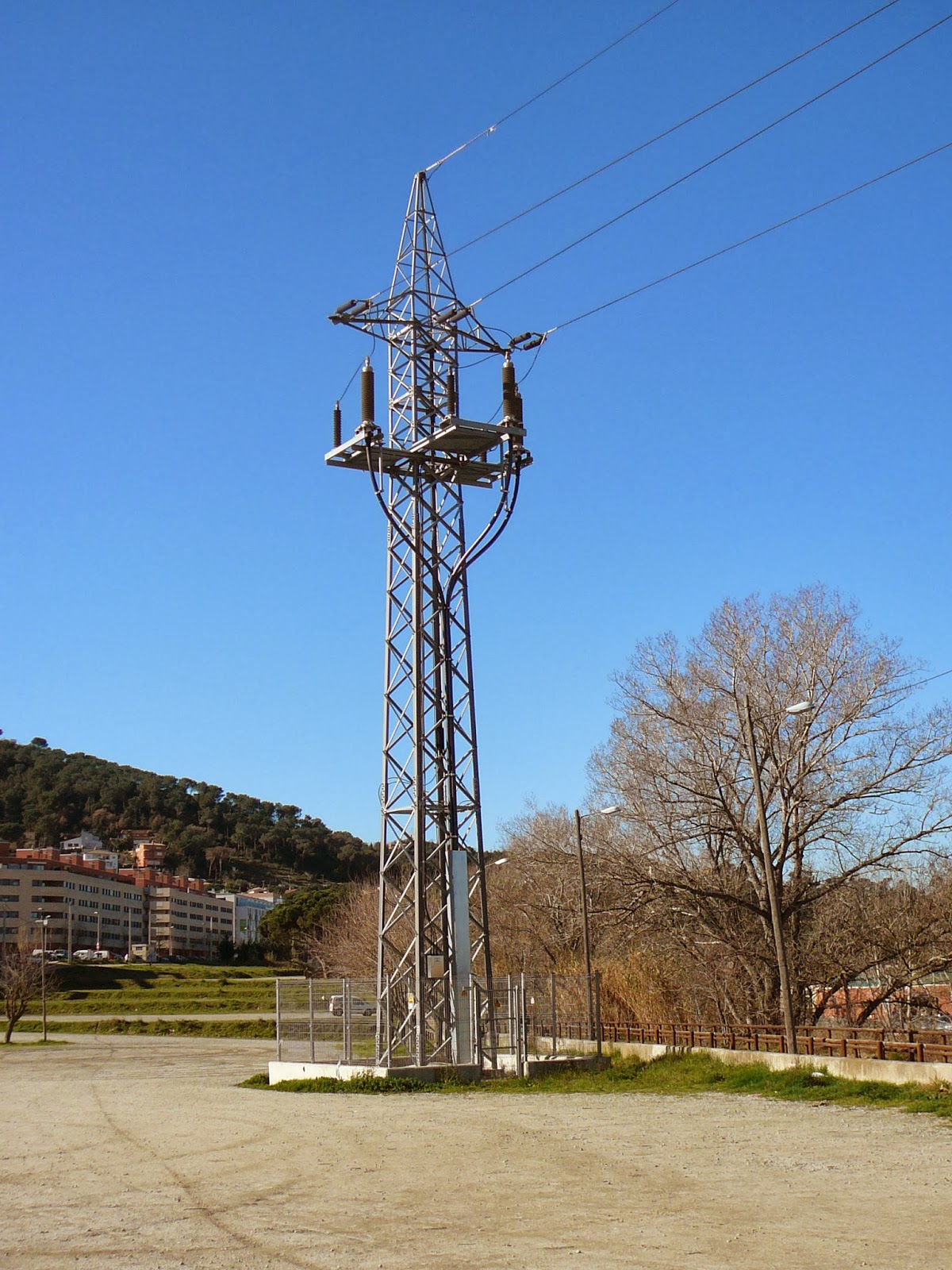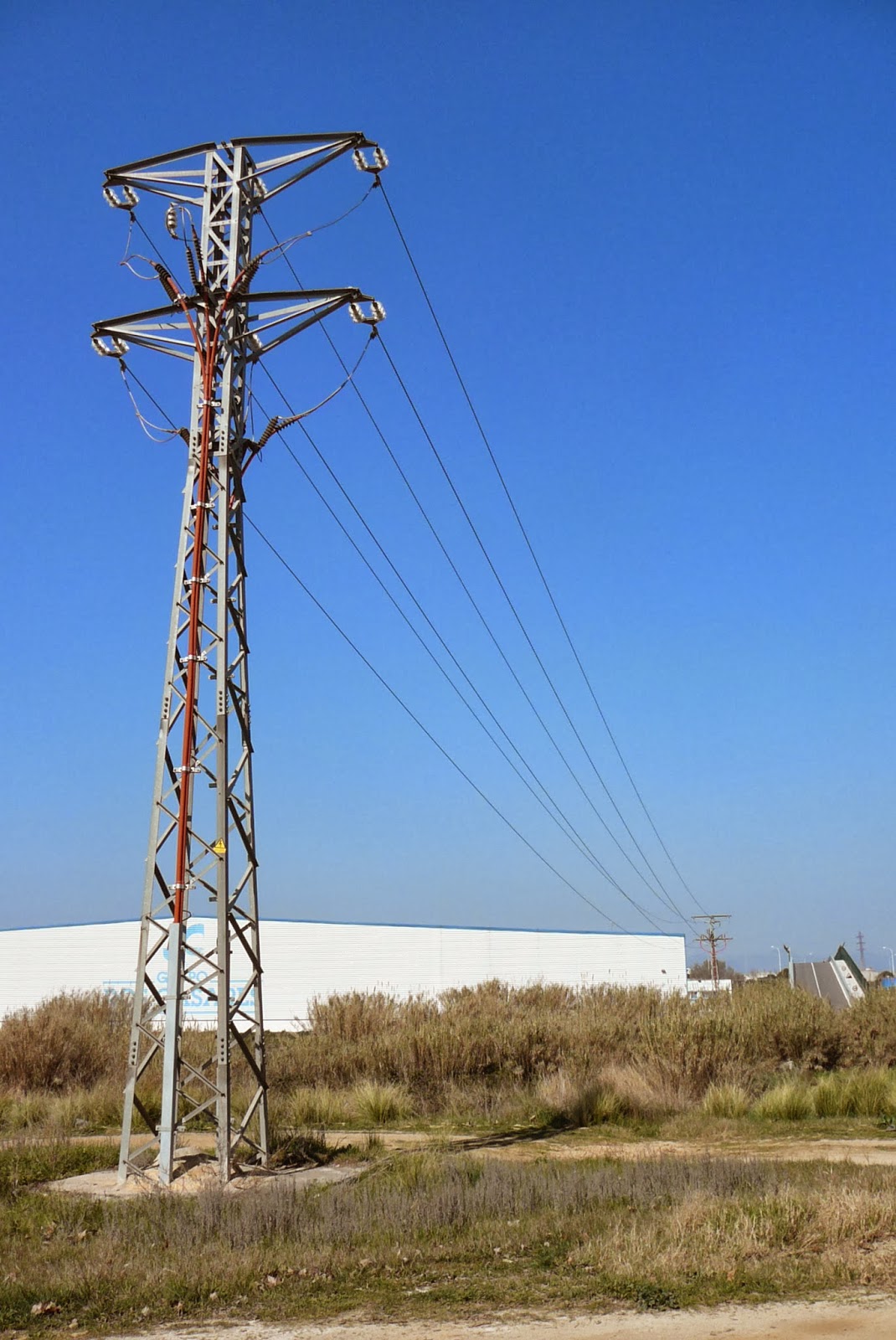Last 9th April, it was possible to visit the Synchrotron Alba, located close Barcelona city. Engineers Association of Barcelona organized one visit to the center, and fortunately for us, the Synchrotron was not in functionality, due to maintenance tasks, being possible to visit the tunnel inside, which normally is not possible due to the risk of radiation.
One Synchrotron is used to make experimental test, mainly for R&D. With one Synchrotron it is possible to get X-Rays. There are two ways for getting X-Rays; a) accelerating the electrons and make it breaks suddenly or, b) changing the trajectory of the electrons from the old or previous trajectory.
X-Rays are used for getting some features and test of material and elements which is not possible to get by other way.
For example, for determined the years of the ink from one antique book, this X-Rays are able to give the properly information.
Figure 1_Synchrotron Building (by InkScape)_Source: Javier Sanchez Rios
How does it work?
Electrons emitted by an electron injection system are first accelerated in a linear accelerator (linac, point 1 of Figure 2), and then transmitted to a circular accelerator (booster synchrotron, point 2 in Figure 2)), where it is accelerated to reach a high energy level. These high-energy electrons are then injected into a circular storage ring (big ring indicated as point 3, in Figure 2). In this storage, ring the electrons are circulating in a vacuum environment, at a constant energy for many hours.Figure 2_ Structure and functionality of the Synchrotron Alba. See the description of every point (1 to 7 in the explanation after figure 2)_source: InkScape by Javier Sanchez Rios from Synchrotron Alba website.
Figure 3_General overview of Synchrotron (180 meters of diameter) , where is possible to see (on the right) 3 of the 37 corners where is finishing the X-Rays of the Synchrotron, but in that case with no application for experimental applications. It is necessary to consider, the block of high-density concrete of 1.5 meters of the structure of the tunnel in this side, because in the inner side, there is no risk of radiation and the block is not with this features_source: Javier Sanchez Rios.
Figure 4_Inside the tunnel of the Synchrotron, on the right, the accelerator ring, on the left, the storage ring of the Synchrotron, with the different magnets. Normally it is not possible to enter in this place due to the possible radiation. In the visit, the Synchrotron was in maintenance process, and there was no risk of radiation. The radiation of X-Rays disappears after some hours_Source: Javier Sanchez Rios
1_Electron production:
Electrons are generated like in a television tube. In that case, the electrons are pre-accelerated by electric fields in a Linear Accelerator
2_Acceleration:
In a Booster Ring, the electrons are further accelerated with the aid of powerful magnetic (20,000 times greater than the magnetic field of the Earth), and electric fields, until they reach velocities greater than 99,999% of the speed of light.
3_Storage:
The electrons are then injected into a Storage Ring, where they are maintained in a circular orbit by strong magnetic fields. Velocity is kept constant by compensating for the energy lost as light emissions with electric fields from a radio-frequency source.
Magnets in a Storage Ring:
- Bending Magnets: essentially dipoles that bend the electron trajectory.
- Quadrupoles: focus the electron beam onto a nominal orbit.
- Sextupoles: reduce the energy dispersion (chromaticity) of the electrons in the ring.
- Correctors: smalls dipoles that correct the electron trajectory in real time.
- Dipoles, Quadrupoes and Sextupoles are activated when the electrons are injected.
- Pulsed Magnets (Septums, Kickers and Bumpers) are used to transfer electrons between accelerators. They produce strong magnetic field in a short period of time. They are built from highly specialized magnetic materials.
Figure 5_ Storage Magnet in Storage Ring, it is possible to see the cables of electric supplying (on the left) and the cooling system by the orange hose (in the right). This kind of magnets are supplied by 600A, therefore, this magnets need the cooling systems by water (cooling jacket)._source: Javier Sanchez Rios
Figure 6_ Sextupole magnet, being possible to see the 6 magnets distributed in the properly way in 360º_source: Javier Sanchez Rios
For getting compensation of the energy lost (due to the impossibility to have 100% vacuum in the ring), and different trajectory to drive the electrons into the beam-lines and out of the storage ring, it is necessary to help the electrons by one system of Radio Frequency, which in the positive half cycle is addressing the electrons to the beam-lines.
Figure 7_Radio Frequency system used for Synchronization of the electrons to change the trajectory ("similarly switch points in the railway"). After this process, the X-Rays are going for the different applications. RF waves are generated by 500MHz in three stations like it is shown in the figure 7, which a consumption of 160MW_source: Javier Sanchez Rios.
4_Beam-lines:
Synchrotron Light is propagated through a Beam-Line, placed tangentially to the ring. There are two types of beam-lines, depending on the Insertion Devices or Bending Magnets are used for light production.
In the Insertion Devices, Synchrotron Light is generated when the electrons are accelerated into a sinusoidal trajectory by a periodic magnetic structure. The light thus obtained is very intense and collimated.
The light then generated is with polychromatic, albeit less collimated and intense than that from the Insertion Devices.
Figure 8_Two different example of beam-line (being out of the storage ring and out of the tunnel). This is the last procedure, 5, 6 and 7 from the Figure 2. Pay attention of the chamber (on the right) which is connecting the beam-line and the tunnel, this is one chamber of lead for avoiding radiation. In terms of test, of course, it depends of the definition of the proposal_source: Javier Sanchez Rios.
For being able to get this X-Rays, it is necessary to get vacuum in the electrons conduction. For that, the system is using one turbine and RF systems for making the vacuum, but at the same time, the system is using one Titan Ion pump for getting the Gamma-Ray. After that, the system is making a light condition, explained in next point 5.
Figure 9_ On the left, the Gamma Vacuum Titan Ion Pump, used for the absorption of particles which are able to interact with electrons and then make it disappear from the beam (energy lost). On the right, the photon beam, systems for helping to concentrate the beam of the X-Ray for a better experimental applications_source: Javier Sanchez Rios.
In an optical "hutch", it gets selected certain wavelenghts, i.e., a small portion of the white electromagnetic spectrum, by means of a monochromator. These photons are transported and focused onto the sample by, for example, bent X-Ray mirrors.
6_Detection:
In an experimental "hutch", the sample is positioned and a detector system collects the experimental data. There are many types of detectors systems, each specialized for a particular application.
7_Data reduction and analysis:
In the control "hutch" the experimental set-up and data collection is under computer control. Data are extracted, reduced, processed and prepared for analysis and/or storage.
The electrons are accelerated and deviated in the storage ring by different magnetics components:
- Bending magnets: they allow to deviate the electrons by several degrees. This deviation results in an tangential emissions of X-Rays by the electrons.
- Undulators: they force the electrons to follow an undulating trajectory. The X-Ray emitted by this undulation will contribute to generate a much more intense beam of light than that generated by the bending magnets.
Figure 10_Undulator Magnet in Alba Synchrotron_source: Javier Sanchez Rios
- Focusing magnets: they allow to keep the electron beam small and well-defined. Smaller and well-defined the electron beam will be, brighter the X-Ray. These magnets are placed in the straight sections of the storage ring.
The X-RAys emitted by the electrons are directed towards the beamlines situated tangentially to the storage ring in the experimental hall. Each beamline is designed to use with a specific technique or for a specific type of research. Experiments run throughout the day and night.
Figure 11_Part of the Facility system, which is supplied by Power district cooling system coming from Gas Co-generation Power plant for supplying all the processes of the Synchrotron; which includes: Hot Water at 40ºC, Compressed Air, Ionized Cold Water, Water for cooling systems at 23ºC, Water for the HVAC at 6ºC, and nitrogen in liquid and gas. On the top left; Facility room, on the top right; Data Center Network for controlling and for Data Aqusition of the process, on bottom left; water pump for the cooling and HVAC systems, on the bottom right; three way-valve for mixing the cooling water coming from the magnets (hot water) with the cold water for different applications_source: Javier Sanchez Rios
____________________
____________________
Applications of X-Rays in Synchrotron of Barcelona and area of investigation:Figure 11_Part of the Facility system, which is supplied by Power district cooling system coming from Gas Co-generation Power plant for supplying all the processes of the Synchrotron; which includes: Hot Water at 40ºC, Compressed Air, Ionized Cold Water, Water for cooling systems at 23ºC, Water for the HVAC at 6ºC, and nitrogen in liquid and gas. On the top left; Facility room, on the top right; Data Center Network for controlling and for Data Aqusition of the process, on bottom left; water pump for the cooling and HVAC systems, on the bottom right; three way-valve for mixing the cooling water coming from the magnets (hot water) with the cold water for different applications_source: Javier Sanchez Rios
____________________
____________________
1_Chemistry: X-Ray analysis of chemical elements allows improvement of production processes for adhesives and lubricants, anti corrosion coating, surfaces electrochemical preparations, hydrophobic coating, etc.
2_Material Science: With X-Rays is possible to establish the three dimensional structure of non-crystalline materials, being this behaviour determined by pressure of nano-crystalline phases or chemical impurities (doping) which is not possible determined by traditional means. By this experimental test, it is possible to know the material's performance.
On the other hand, the beam is used in the study of special alloys for using in Aerospace technology; the electronic and atomic structure of catalysts: semiconductors, superconductors, and how these properties depend on high pressure or temperature.
3_Magnetism: soft X-Ray magnetic circular dichroism, are used to image the magnetic domains in thin films and mono-layers. These are essential in sensors and data storage devices. In addiction, Synchrotron Light is used for "in situ" detection of magnetic micro structures.
4_Life Science: X-Ray diffraction is used to study the structural/functional changes undergone by; DNA, proteins and macromolecules, hormones, enzymes and viruses.
As example: muscles, and other biological systems, convert chemical energy into force or motion. Muscle molecules undergo subtle and rapid conformational changes that only Synchrotron Light is capable of detecting. It is thanks to such techniques which provides sequences of molecular events responsible for molecular contraction.
5_Macromolecular Crystallography: After the completion of Human Genome Project, it is possible to crystallize many biological macromolecules intimately involved in a given biological target. Synchrotron Light has solved the atomic structure of many biological macromolecules and will continue to do so until all the proteins structures (in excess of 50,000) derived from the knowledge acquired in the Human Genome Project are solved. One important recent example is the atomic structure of the biological protein manufacturing machinery.
6_Industry: In the past, many industrial processes such as polymer and ceramics production, depended on the skills of the experts and on chance. Great control and predictability has now carried out with Synchrotron Light.
Other Industrial applications are in areas such as electronics (e.g.: chip manufacturing), micro-mechanics (e.g.: manufacture of sub-micron devices used in medical or sensors applications), Aerospace Industry (e.g.: detector, calibration), Environmental Industry (e.g.: analysis of contaminated soils and/or plants)
PS: For getting information of the current status of the Synchrotron, please visit this website.
Bibliography:
Synchrotron Alba
























